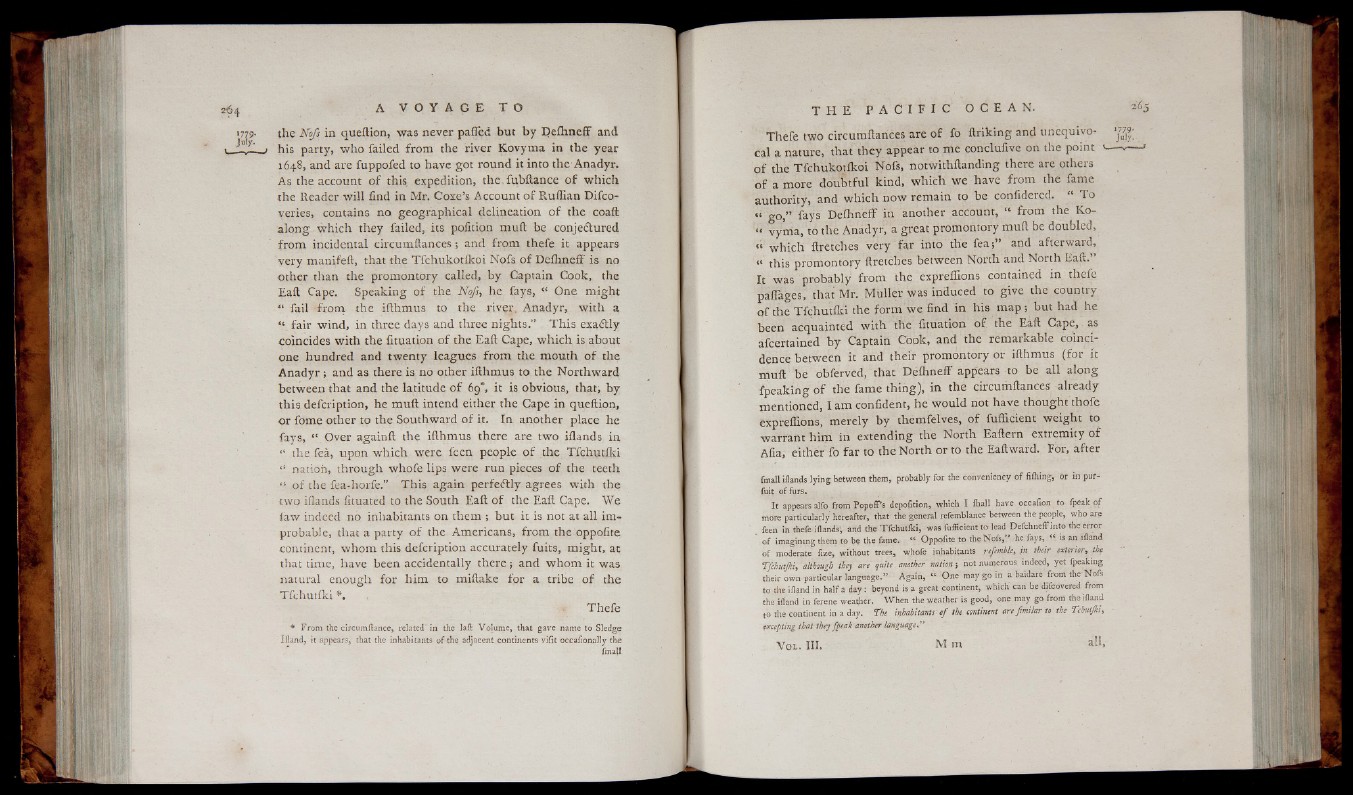
the Nofs in queftion, was never pafled but b y DeihnefF and
his party, who failed from the river Kovyma in the year
1648, and are fuppofed to have got round it into the Anadyr.
As the account o f this expedition, the fubftance o f w hich
the Reader w ill find in Mr. Coxe’s Account o f Ruffian Difco-
veries, contains no geographical delineation o f the coail
a lon g w hich they failed, its pofidan m u ll be conjedtured
from incidental circumftances; and from thefe it appears
ve ry manifeft, that the Tfchuk otik oi Nofs o f DeihnefF is no
other than the promontory called, b y Captain Cook, the
Eaft Cape. Speaking o f the Nofs, he fays, “ One might
“ fail from the ifthmus to the river. Anadyr, w ith a
“ fair wind, in three days and three nights.”;. T h is exadtly
coincides with the fituation o f the Eaft Cape, w h ich is about
one hundred and twenty leagues from the mouth o f the
A n a d y r ; and as there is no other ifthmus to the Northward
between that and the latitude o f 6g”, it is obvious, that, by
this defcription, he muft intend either the Cape in queftion,
o r fome other to the Southward o f it. In another place he
fays, “ Over againft the ifthmus there are two iflands in
the feá, upon w h ich were feen people o f the Tfchutiki
“ nation, through whofe lips were run pieces o f the teeth
“ o f the fea-horfe.” T his again perfectly agrees with the
two iflands fituated to the South Eaft o f the Eaft Cape. We
faw indeed no inhabitants on them ; but it is not at all im probable,
that a party o f the Americans, from the oppofite
continent, whom this defcription accurately fuits, might, at
that time, have been accidentally th e re ; and whom it was
natural enough for him to miftake fo r a tribe o f the
T fch u t ik i* .
The fe
* From the circumilance, related' in the laft Volume, that gave name to Sledge
Ifland, it appears, that the inhabitants of the adjacent continents vifit occafionally the
fmaji
Thefe two circumftances are o f fo ftrikin g and unequivo- w
cal a nature, that they appear to me conclufive on the point < —
o f the T fchu k otik oi Nofs, notwithftanding there are others
o f a more doubtful kind, w h ich we have from the fame
authority, and w hich now remain to be confidered. “ To
I go ,” fays DeihnefF in another account, “ from the Ko-
“ vyma , to the Anadyr, a great promontory muft be doubled,
w hich ftretches ve ry fa r into the fe a ;” and afterward,
“ this p r o m o n t o r y ftretches between North and North Eaft.”
It was probably from the expreffions contained in thefe
pafiages, that Mr. Muller was induced to give the country
o f the T fch u tik i the form we, find in his m a p ; but had he
been acquainted w ith the fituation o f the Eaft Cape, as
afcertained b y Captain Cook, and the remarkable coincidence
between it and their promontory or ifthmus (for it
muft be obferved, that DeihnefF appears to be all along
fp eaking o f the fame thing), in the circumftances already
mentioned, I am confident, he would not have thought thofe
expreffions, merely b y themfelves, o f fufficient weigh t to
warrant him in extending the North Eaftern extremity o f
Afia, either fo far to the North or to the Eaftward. For, after
fmall iflands lying between them, probably for the conveniency of fiihing, or in pur-
fuit of furs.
It appears alfo from PopefPs depofition, which I ihall have occailon to fpeak of
more particularly hereafter, that the general refemblance between the people, who are
feen in thefe iflands; and the Tfchutiki, was fufficient to lead Defchneff into the error
' o f imagining them to b<? the fame. “ Oppofite to the Nofs,” he fays, “ is an ifland
of moderate fize, without trees, whofe inhabitants refemble^ jn their exterior^ the
Tfchutjki, although they are quite another nation j not numerous indeed, yet fpeaking
their own particular language.” Again, “ One may go in a baidare from the Nofs
to the ifland in half a day: beyond is a great continent, which can be difcovered From
theiiiand in ferene weather. When the weather is good, one may go from theifland
to the continent in a day. The inhabitants'of the continent are fimilar to the Tchutjki^
excepting that they fpeak another language
V o l . III. M m a f t .